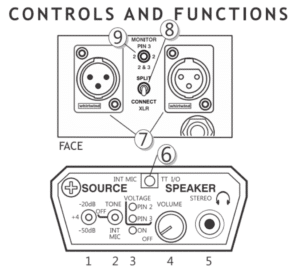As an Amazon Associate DcSoundOp earns from qualifying purchases.
Why the Whirlwind Qbox is still the killer Audio Tester
If you’re only looking to spot check lines and send out tone, the Whirlwind Qbox is a pricey, 9v battery eating chonker. They are more expensive now than ever before, and lately everyone has been loving the inexpensive RAT Sniffer/Sender & the tiny new Sonnect Sound Bullet. (To be clear, I’d suggest owning all three, as they do not perform the same functions, but people consistently love to compare them). Since this keeps coming up, let’s talk about a few things that makes the Qbox so special.
Party-Line, Excellent!
Have you ever needed a party-line intercom, but didn’t want to shell out the dough or drag along the extra gear? Well, the Qbox features an internal omni-directional microphone. This microphone can be used simply to talk down the line you are connected to, which can be really helpful. However, if you have another Qbox and a pair of headphones, you’re set. You can make a simple party-line intercom just by connecting the two together. Crazy, right? You need headphones at each end to defeat the speaker so it doesn’t feedback into the mic. But, you can also patch the headphone out into a channel on your mixer and solo there to listen. This allows your headphones to still be used as normal.
IFB Amplifier
Many folks in the live sound world don’t work with IFB earpieces too often, it’s more of a broadcast thing. Funny enough, most live sound technicians have an IFB amplifier in their kit and don’t even know it. If you ever get asked for an IFB feed, you can rest easy knowing you have it covered. All you need is to send a line level signal to the Qbox. Then plug a high-impedance IFB earpiece into the 1/4″ TS jack provided on the front panel, and you’re set. Don’t use the headphone amp output. The Qbox’s belt clip comes in very hand in these situations. You can clip it on the talent, or onto a gaff tape hanger on their chair. You can also use a 9V 100mA battery eliminator to plug into more capable power sources.

TT Jack
A lot of folks miss it, but that hole at the top isn’t just for the microphone. Notice how it says [INT MIC] on one side and [TT I/O] on the other side? Well it is actually a TT jack. It is wired in parallel with the output XLR, pin 2 to tip and pin 3 wired to the ring. With the XLR split switch in the connected position, you can use the TT jack to monitor external signals or to send tone or the internal microphone out to other equipment. This is very handy in a broadcast truck or anywhere else you see TT patch bays.
Amazon and the Amazon logo are trademarks of Amazon.com, Inc, or its affiliates.

